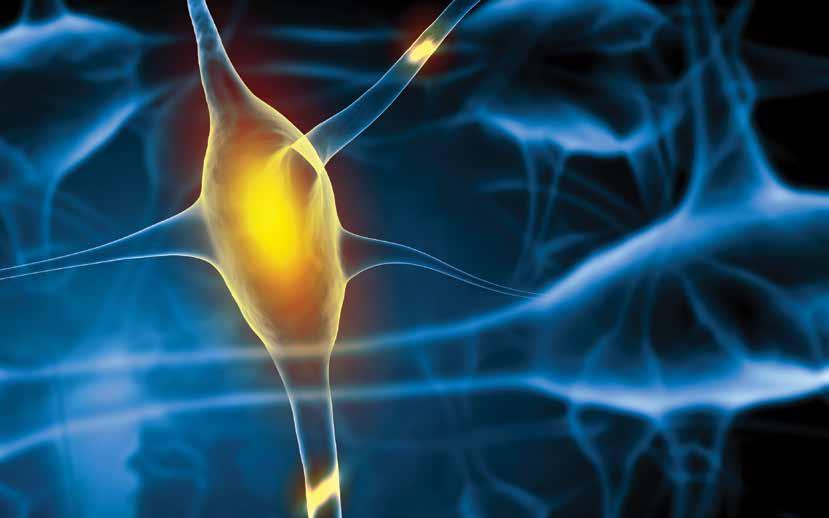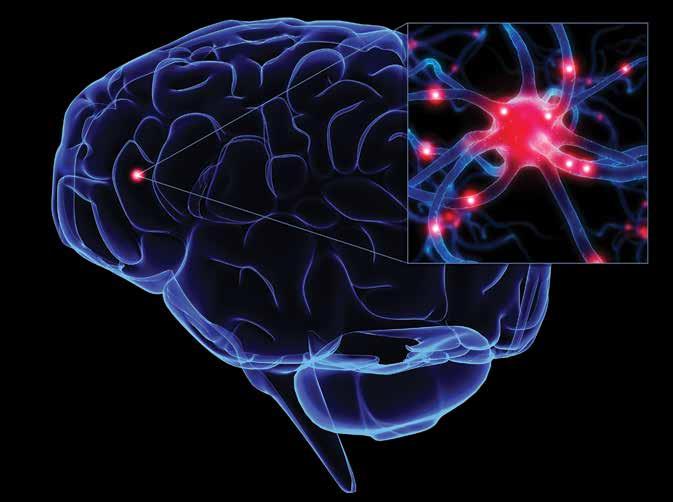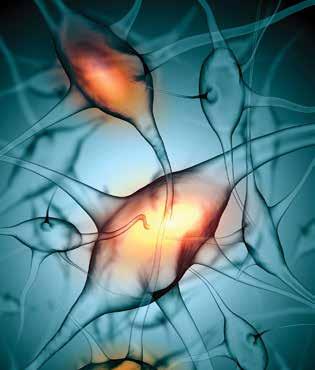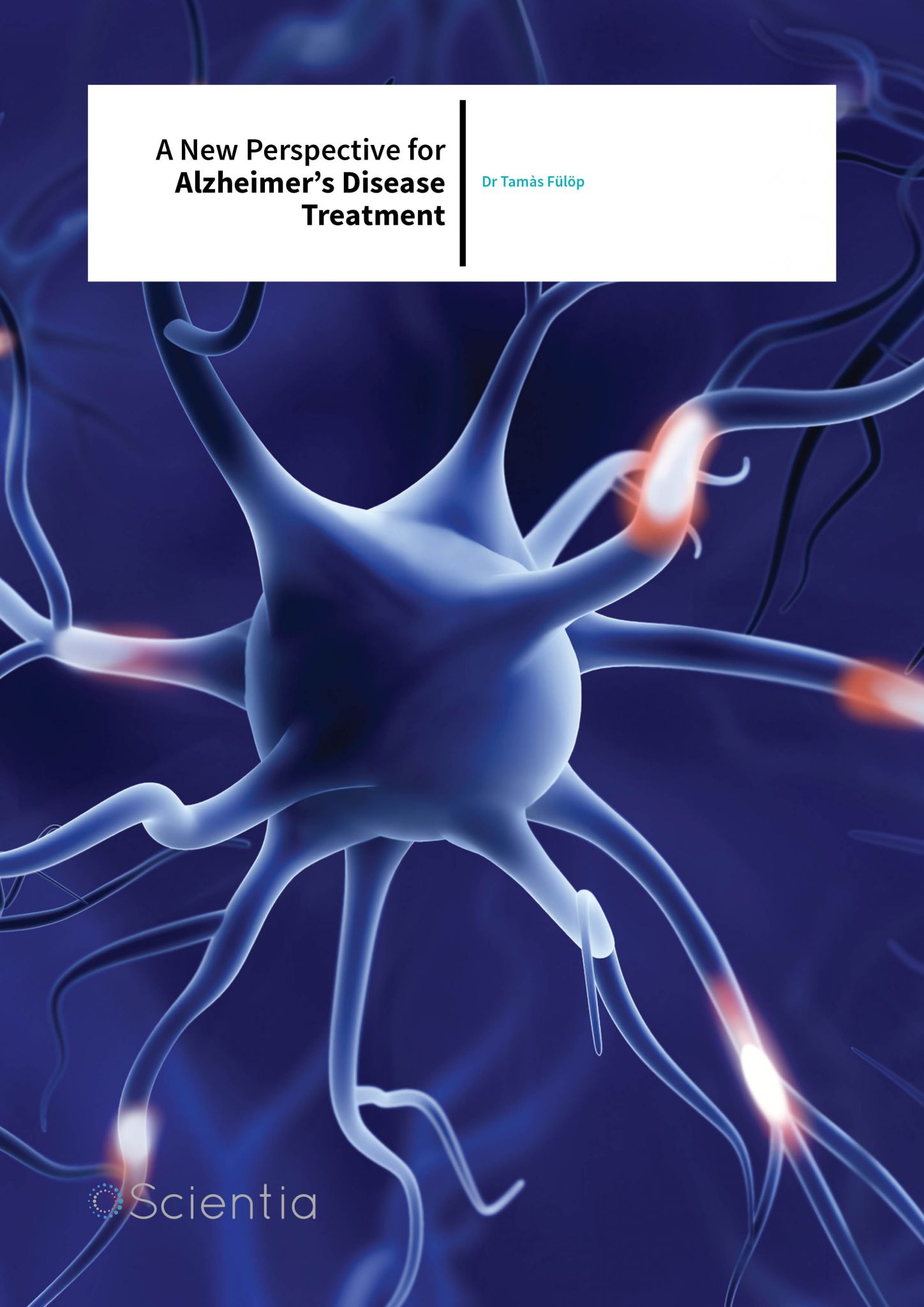Dr Tamàs Fülöp – A New Perspective For Alzheimer’s Disease Treatment
Nearly all of the clinical trials for Alzheimer’s treatments have failed, leading many to wonder whether pharmaceutical companies have been chasing the wrong targets. Dr Tamàs Fülöp and his colleagues at the University of Sherbrooke are leading the charge to investigate neglected aspects of the disease in order to find new targets.

Alzheimer’s disease– what we know
Alzheimer’s disease causes progressive damage in the brain, leading to irreversible problems with memory, cognition and social engagement, eventually leaving the patients unable to care for themselves. It is the most common form of dementia in the world and the risk of being affected increases with age. Current projections predict that the number of cases will continue to rise dramatically in the future as our life expectancy increases, placing a heavy burden on the health care system and care givers.
The hallmarks of the disease are numerous. Diagnostic criteria include neuronal loss and synaptic dysfunction which together amplify the breakdown in communication between neurons, ultimately leading to their death. A protein called amyloid precursor protein (APP) normally found in healthy neurons, is chopped into peptides of varying lengths according to two different pathways. One is called the non-amyloidogenic pathway and is not associated with pathology. In contrast, the other pathway called the amyloidogenic pathway generates fragments that include a 42 amino acid-long amyloid beta fragment that may become toxic to the brain. Under pathological conditions such as in Alzheimer’s disease, amyloid beta accumulates and aggregates on the outside of neuronal cells, forming plaques in the brain. Another hallmark of Alzheimer’s involves the Tau protein. This protein is normally found in abundance in neural tissue, but becomes irreversibly modified to form fibrous tangles that aggregate and deposit inside neuronal cells. This causes these proteins to lose their important role in axonal transport, which is to help molecules shuttle from the cell body, where the nucleus is housed, to its synapse – a specialised structure where information is exchanged between adjacent neurons.
The question remains whether these two hallmarks are the cause of Alzheimer’s disease or merely the consequence of another upstream triggering event. Amyloid beta aggregation, for example, can be seen before the symptoms of Alzheimer’s appear, placing it as an early event but without evidence of a direct connection with onset of the disease. The question thus arises: what are the events that initiate Alzheimer onset and progression?
A renegade immune system
Whereas the exact mechanism of Alzheimer’s disease remains elusive, some links have been made to a host of factors including gene susceptibility, metabolic disorders and brain inflammation. In addition, vascular risk factors such as hypertension and hypercholesterolemia have been suggested as additional factors that may contribute to the development of Alzheimer’s disease. One indisputable characteristic of the disease is chronic inflammation of the brain and the periphery. The system that comprises the brain and spinal cord in humans, termed the central nervous system, is considered an immunologically privileged site, which means that cells outside this system cannot enter due to a protective ‘wall’ – the blood-brain barrier. This wall, however, is not without its cracks. It can be compromised following insult, or infections leading to a permissive communication between mediators of inflammation in the periphery (cells, inflammatory proteins) and the brain.
The response of the brain is propagated by members of the innate immune system such as microglial cells, which guard the brain and its occupants. Normally in a resting state, they become activated by plaque formation due to increasing numbers of amyloid beta peptides. They produce other mediators such as pro-inflammatory cytokines, neurotrophic factors and proteases to remove agglutinated amyloid beta, and to combat infection. All of these mediators combine to eliminate the aggression through engulfing and clearing debris, such as amyloid beta peptides, thus protecting the cells against damage. At the end of the aggression, they contribute to the resolution of the inflammation. However, under circumstances of sustained aggression this situation becomes chronic. Consequently, increased levels of proinflammatory cytokines are found in the brain and its surrounding fluid in Alzheimer’s patients compared to controls, corroborating this mechanism.
The response to amyloid beta aggregates is triggered by the expression of specific receptors on the brain reactive cells such neurons, astocytes and microglia. The greater the amount of amyloid beta peptides, the more microglial cells that will be activated in response, subsequently releasing more cytokines, and creating a positive feedback loop. Therefore, this normally regulated process can become aberrant, or renegade, leading to a sustained inflammatory response. This is also exacerbated by ‘CNS immune senescence’, a process whereby agerelated structural changes in microglial cells occur, subsequently causing deterioration of their ability to provide neuroprotection.
Outside the central nervous system, a peripheral immune surveillance team is also hard at work patrolling for unwanted guests. Evidence also shows that members of this team can also be summoned into action during the course of the disease. This includes members of the adaptative immune system, a much more sophisticated system than that of the innate response. Unlike the innate immune response, the adaptative response is very specific to the particular insults that induced them, and can provide long lasting protection. However, they can also exacerbate the response by releasing more pro-inflammatory cytokines and further contributing to inflammation.

One indisputable characteristic of Alzheimer’s disease is chronic inflammation of the brain and the peripheral nervous system.
Leaving no stone unturned
Part of Dr Fülöp’s work concerns natural killer cells, a rarely-studied component of the innate immune system as it relates to Alzheimer’s disease. His team performed the first analysis of these cell types in patients suffering from amnesic mild cognitive impairment, believed to be an early stage of the disease associated with prominent memory decrease with no functional changes. In most cases, this affliction will become more severe and progress to Alzheimer’s disease within a time as short as three years. Natural killer cells survey the central nervous system for signs of infection or stress. True to their name, they kill target cells that have become useless or are detrimental to the host. They are classified on the basis of the proteins they express on their cell surface which directly relates to their specific function. If, for example, one subpopulation of these killer cells decreases in number with age, they may be unable to effectively destroy an upstream mediator of amyloid beta plaque formation and this may serve as a clue for the early detection of immune alterations in the progression of Alzheimer’s disease.
What the team found highlighted the complexity of this disorder. Differences in natural killer cell populations did not correlate with a pattern of progression from healthy to mild cognitive impairment to full-blown Alzheimer’s. Rather, it appeared to be a signature unique to the individuals with mild cognitive impairment, which then disappeared upon disease progression. Dr Fülöp theorised that natural killer cells may therefore be involved in an active attempt by the immune system to respond to an as-yet-unidentified pathology during this early stage of memory impairment. When attempts to stop this pathological insult fail, progression to Alzheimer’s disease occurs. This situation is similar to that which is seen in rheumatoid arthritis, for example. It nonetheless proves that no immune component should be left unscrutinised when searching for potential drug candidates.
 Viruses – unlikely suspects
Viruses – unlikely suspects
Most new Alzheimer’s drugs try to eliminate the characteristic plaques within the brain caused by amyloid beta deposits and quell the immune response. These drugs have, up to now, led to severe side effects and have sadly shown that clearing these plaques alone does not result in any cognitive improvement.
Once again breaking from tradition, Dr Fülöp is among a team of scientists who believe that microbes could be the instigators of this cascade of events, and by focusing more research efforts on their etiology, one may be able to slow or even arrest Alzheimer’s disease progression. These infectious agents, including herpes simplex virus type 1 (HSV1), Chlamydophila pneumoniae and spirochetes can enter the central nervous system and remain there in a dormant state. The protective effect of the immune system declines with age allowing these pathogens to undergo reactivation in the brain. As a consequence, they cause neuronal damage by direct microbial activity or by triggering inflammation. This can happen repeatedly, leading to or contributing to hallmarks of the disease.
There are many lines of evidence to support an infectious component of Alzheimer’s disease. Viruses and other microbes are found within the brain of most elderly people. In the brains of immunosuppressed patients, HSV1 DNA has been found to be expressed in greater quantities. Moreover, in the brains of Alzheimer’s patients, HSV1 DNA was expressed within amyloid beta plaques. The inflammatory cascade of the disease is similar to that which occurs during infection, and features of the disease are transmissible by inoculation of the Alzheimer’s disease brain to primates or mice. Finally, genome wide association studies, which investigate correlations between genetic alterations and disease, found that variations in a gene which modulates immune function and susceptibility to infectious disease, apolipoprotein E, and especially apoE4, also carries a risk of Alzheimer’s disease.
Evidence further supports that the infectious agents are not just innocent bystanders in this saga. Brain infection is linked with Alzheimer’s disease-like pathology in humans, while in mice and cultured cells amyloid beta accumulation was observed following infection with HSV1. Antiviral drugs, such as acyclovir, were also able to block HSV1-induced pathology in cultured cells. The last clue arises from an early symptom of Alzheimer’s disease – olfactory dysfunction. The olfactory nerve leads directly to an area of the brain where the characteristic Alzheimer’s pathology is routinely seen and eventually disseminates. This nerve is also a likely entry point of HSV1 and other viruses into the brain, thus implicating viruses at this initial site of damage. Dr Fülöp theorised that natural killer cells may be involved in an active attempt by the immune system to respond to an as-yetunidentified pathology during early stages of memory impairment.
Previously unsuspected, amyloid beta induction may initially have a protective role against pathogenic agents. Amyloid beta is normally produced by neurons at a rate required to fulfill their everyday function. This includes maintaining synaptic plasticity, the ability of the synapse to strengthen or weaken over time in response to a change in their activity, memory and antimicrobial protection. Dr Fülöp’s group was one of two groups to present evidence that amyloid beta possesses antiviral activity against HSV-1 as well as other viruses. They hypothesise that production of amyloid beta may represent an initial self-defence attempt by the brain to curtail viral, and possibly other, aggressions. This is done through amyloid beta phagocytosis by microglial cells and the subsequent release of pro-inflammatory factors that sustain microglia activation. The situation turns awry when viral reactivation becomes more frequent, particularly with aging when microglial cells become less efficient at eliminating viruses and amyloid beta. Amyloid beta is then overproduced and accumulates, interfering with its normal, physiological function and triggering a critical inflammatory state leading to neuronal loss and eventually, the development of Alzheimer’s disease. In short, a vicious cycle is set into motion where damage is amplified over time and becomes irreversible.
The future of Alzheimer’s treatment
The failure of 413 trials of Alzheimer’s therapy carried out over the past fifteen years is a clear indication that the research community is ready for some new ideas. Dr Fülöp is among the voices proposing a deeper look at alternative treatment routes to overcome this frustrating impasse. The role of viral and other infectious agents in the pathogenesis of Alzheimer’s disease may be a promising start.
Meet the researcher

Dr Tamàs Fülöp
Full Professor
Department of Medicine, Faculty of Medicine and Health Sciences
Université de Sherbrooke, Quebec, Canada
Dr Tamàs Fülöp is Assistant Director of the Research Center on Aging and Full Professor at the Faculty of Medicine and Health Sciences of the Université de Sherbrooke in Quebec, Canada. He obtained his PhD degree in immunology and gerontology from the University of Debrecen in Hungary, and he then carried out postdoctoral research training in the field of biochemistry of connective tissues at Paris, University Val de Marne’ , in France. He also holds a MD Internal Medicine/Geriatrics degree, and is currently the head of the Immune Inflammation Laboratory. His current research interests include immunity in relation to aging.
CONTACT
T: (+1) 819 780 2220
KEY COLLABORATORS
Professor Gilles Dupuis, PhD, Université de Sherbrooke
Professor Eric Frost, PhD, Université de Sherbrooke
Dr Karine Bourgade, PhD, Post-doctoral fellow, Université de Toulouse
Ms Aurélie Le Page, PhD Student, Université de Sherbrooke
Professor Jacek M Witkowski, MD, PhD, University of Gdansk
Professor Graham Pawelec, PhD, University of Tübingen
Professor Anis Larbi, PhD, Singapore immunology Network, A*Star, Singapore
Professor Stephen Cunnane, PhD, Université de Sherbrooke
Professor Guy Lacombe, MD, Université de Sherbrooke
FUNDING
This work was supported by grants from Canadian Institutes of Health Research (CIHR) (No. 106634), the Université de Sherbrooke, the Société des Médecins de l’Université de Sherbrooke (SMUS) and the Research Center on Aging.
REFERENCES
Bourgade K, Le Page A, Bocti C, Witkowski JM, Dupuis G, Frost EH, Fülöp T, Protective Effect of Amyloid-ß Peptides Against Herpes Simplex Virus-1 Infection in a Neuronal Cell Culture Model, J Alzheimers Dis., 2016, 50, 1227–1241.
Le Page A, Bourgade K, Lamoureux J, Frost E, Pawelec G, Larbi A, Witkowski JM, Dupuis G, Fülöp T, NK Cells are Activated in Amnestic Mild Cognitive Impairment but not in Mild Alzheimer’s Disease Patients, J. Alzheimers Dis., 2015, 46, 93–107.
Bourgade K, Garneau H, Giroux G, Le Page AY, Bocti C, Dupuis G, Frost EH, Fülöp T Jr., ß-Amyloid peptides display protective activity against the human Alzheimer’s disease-associated herpes simplex virus-1, Biogerontology, 2015, 16, 85–98.
Goldeck D, Witkowski JM, Fülop T, Pawelec G, Peripheral immune signatures in Alzheimer Disease., Curr Alzheimer Res., 2016, Feb 21.
Itzhaki RF, Lathe R, Balin BJ, Ball MJ, Bearer EL, Braak H, Bullido MJ, Carter C, Clerici M, Cosby SL, Del Tredici K, Field H, Fulop T, Grassi C, Griffin WS, Haas J, Hudson AP, Kamer AR, Kell DB, Licastro F, Letenneur L, Lövheim H, Mancuso R, Miklossy J, Otth C, Palamara AT, Perry G, Preston C, Pretorius E, Strandberg T, Tabet N, Taylor-Robinson SD, Whittum-Hudson JA, Microbes and Alzheimer’s Disease, J Alzheimers Dis., 2016, Mar 8.pii:S0304–3835(15), 00771–5.

